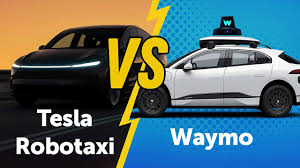
Elon Musk’s bullish push to scale a camera-first robotaxi fleet rapidly sits in stark contrast to Waymo’s methodical, sensor-heavy, map-by-map expansion. The divergence is not merely academic: it recasts what the industry will prize in its early winners — whether low upfront hardware cost and rapid geographic reach, or conservative deployment with tight operational controls that aim to reduce incidents and regulatory friction. Both approaches carry trade-offs that will shape investor expectations, municipal partnerships and the pace at which driverless vehicles become a mainstream transportation option.
Tesla betting on vision and AI to leapfrog prep work
Tesla argues that a vision-only system — cameras coupled with large-scale neural-network training on billions of miles of driving data — can replicate human perceptual and decision processes without the need for expensive sensors, pre-mapped terrain or lengthy market-specific calibration. That approach, Tesla executives and backers contend, lowers the hardware cost per vehicle and avoids the time-intensive mapping and geo-labelling that
Waymo uses. Tesla’s June 2025 Austin pilot and subsequent area expansions are being framed internally as a proof point for rapid geographic scaling once the underlying AI demonstrates robust generalisation from a handful of real-world environments to many more. The company’s public timeline and projections envision a fast, software-driven rollout that could, if realized, dramatically compress the time to national coverage.
Tesla’s playbook emphasises data-scale advantages and inference efficiency: cheaper sensor suites allow broader fleet installation, while large volumes of edge data and fleet learning are meant to accelerate improvement. Commercially, that lowers the upfront capital needed to field a robotaxi service and could make per-ride economics much more attractive — provided the system handles edge cases and severe weather reliably. The risk Tesla accepts is that vision-only systems face known limitations in low-visibility conditions and in novel, highly ambiguous traffic scenarios; these are the situations regulators and city officials often cite as the primary safety concerns for public deployment.
Waymo’s mapping, sensor redundancy and staged entry as safety-first strategy
By contrast, Waymo’s architecture layers lidar, radar and cameras atop detailed, high-definition maps and a phased introduction plan that moves from simulation and closed-course testing to supervised on-street trials and, ultimately, fully driverless public service. Waymo’s market expansion has been deliberate: years of city-specific mapping and iterative testing in Phoenix, San Francisco and other territories have been followed by cautious increases in service area and operational complexity. That method aims to reduce surprise behaviours, make vehicle responses predictable in complex urban environments and provide defensible evidence to regulators and civic partners that vehicles are ready for broader deployment.
Waymo’s sensor redundancy — multiple sensing modalities feeding conservative, rules-aware decision systems — is designed to handle a broader range of edge cases without reliance on human intervention. The company’s play anticipates higher upfront costs from hardware and mapping, but seeks to lower downstream friction from incidents, citations and public scepticism. For cities focused on safety records and controlled integration with existing traffic management, Waymo’s path offers a lower-risk, if slower, template for adoption.
Commercial consequences: cost, speed and regulatory exposure
The two models imply sharply different commercial trajectories. Tesla’s lower hardware cost per unit suggests faster fleet expansion and the potential for earlier unit-economics improvements if software performance meets expectations. That could make Tesla’s offering more competitive on price and scale, especially in sprawling U.S. suburbs and cities with fewer extreme mapping complexities. Waymo’s capital-intensive model, however, may win trust from municipal regulators and enterprises that place a premium on demonstrated safety and predictable behaviour, positioning it to capture higher-value, mission-critical mobility contracts even if overall growth is steadier.
Regulatory and public acceptance will be deciding factors. Incidents — whether a vehicle ignoring officers’ directions or entering hazardous conditions — amplify scrutiny and can materially slow approvals. Waymo’s approach aims to minimise these flashpoints through pre-emptive mapping and staged testing. Tesla’s faster cadence risks heightened regulatory pushback if early deployments trigger safety controversies; the company’s ability to rapidly address and learn from incidents will determine whether speed translates into sustainable market share or into a pattern of stop-start rollouts.
At a technical level the debate centres on two core engineering problems: perception redundancy and edge-case generalisation. Waymo addresses the first by adding sensing channels (lidar and radar) to provide 3D situational awareness and multiple independent confirmations of the same object or risk. Tesla relies on machine learning generalisation, arguing that a single, flexible sensor modality — cameras — can learn robust scene understanding from very large, diverse datasets. Both camps concede limitations: multi-sensor stacks add cost and complexity, while vision-only systems must demonstrate consistent performance across conditions that are under-represented in training data.
Industry players and analysts therefore view the competition as complementary in the near term: Waymo’s model will set conservative benchmarks for urban safety and regulator comfort, while Tesla’s model, if it proves resilient, could democratise robotaxi economics and spur more rapid consumer adoption. The winner in any given city may reflect local priorities — cost sensitivity, weather regimes, regulatory appetite and infrastructure readiness — rather than a universal technical victor.
Market dynamics and who benefits first
Investors are already pricing different expectations into the two firms: rapid scale claims can lift market valuations if they appear credible, while steady, capital-heavy builds require patience but can deliver durable revenue streams once operations scale. Smaller mobility players, municipal transit agencies and fleet operators will watch carefully for signals of reproducibility. If Tesla’s method demonstrably reduces per-vehicle cost without a spike in safety incidents, legacy automakers and ride-hail incumbents may race to adopt similar vision-centric stack designs. Conversely, if Waymo’s steady approach produces lower incident rates and smoother regulatory paths, it will strengthen the case for partnerships that prioritise reliability over speed.
The next phase of the robotaxi era will therefore be shaped less by an absolute technical truth than by which model better navigates the intertwined pressures of hardware economics, public safety, local regulation and real-world edge cases. Over the short term, cities and riders will serve as labs; over the medium term, the industry will coalesce around practices that balance cost, scale and trust — or fragment into niches where each approach commands different segments of urban mobility.
(Source:www.invesitng.com)
Tesla betting on vision and AI to leapfrog prep work
Tesla argues that a vision-only system — cameras coupled with large-scale neural-network training on billions of miles of driving data — can replicate human perceptual and decision processes without the need for expensive sensors, pre-mapped terrain or lengthy market-specific calibration. That approach, Tesla executives and backers contend, lowers the hardware cost per vehicle and avoids the time-intensive mapping and geo-labelling that
Waymo uses. Tesla’s June 2025 Austin pilot and subsequent area expansions are being framed internally as a proof point for rapid geographic scaling once the underlying AI demonstrates robust generalisation from a handful of real-world environments to many more. The company’s public timeline and projections envision a fast, software-driven rollout that could, if realized, dramatically compress the time to national coverage.
Tesla’s playbook emphasises data-scale advantages and inference efficiency: cheaper sensor suites allow broader fleet installation, while large volumes of edge data and fleet learning are meant to accelerate improvement. Commercially, that lowers the upfront capital needed to field a robotaxi service and could make per-ride economics much more attractive — provided the system handles edge cases and severe weather reliably. The risk Tesla accepts is that vision-only systems face known limitations in low-visibility conditions and in novel, highly ambiguous traffic scenarios; these are the situations regulators and city officials often cite as the primary safety concerns for public deployment.
Waymo’s mapping, sensor redundancy and staged entry as safety-first strategy
By contrast, Waymo’s architecture layers lidar, radar and cameras atop detailed, high-definition maps and a phased introduction plan that moves from simulation and closed-course testing to supervised on-street trials and, ultimately, fully driverless public service. Waymo’s market expansion has been deliberate: years of city-specific mapping and iterative testing in Phoenix, San Francisco and other territories have been followed by cautious increases in service area and operational complexity. That method aims to reduce surprise behaviours, make vehicle responses predictable in complex urban environments and provide defensible evidence to regulators and civic partners that vehicles are ready for broader deployment.
Waymo’s sensor redundancy — multiple sensing modalities feeding conservative, rules-aware decision systems — is designed to handle a broader range of edge cases without reliance on human intervention. The company’s play anticipates higher upfront costs from hardware and mapping, but seeks to lower downstream friction from incidents, citations and public scepticism. For cities focused on safety records and controlled integration with existing traffic management, Waymo’s path offers a lower-risk, if slower, template for adoption.
Commercial consequences: cost, speed and regulatory exposure
The two models imply sharply different commercial trajectories. Tesla’s lower hardware cost per unit suggests faster fleet expansion and the potential for earlier unit-economics improvements if software performance meets expectations. That could make Tesla’s offering more competitive on price and scale, especially in sprawling U.S. suburbs and cities with fewer extreme mapping complexities. Waymo’s capital-intensive model, however, may win trust from municipal regulators and enterprises that place a premium on demonstrated safety and predictable behaviour, positioning it to capture higher-value, mission-critical mobility contracts even if overall growth is steadier.
Regulatory and public acceptance will be deciding factors. Incidents — whether a vehicle ignoring officers’ directions or entering hazardous conditions — amplify scrutiny and can materially slow approvals. Waymo’s approach aims to minimise these flashpoints through pre-emptive mapping and staged testing. Tesla’s faster cadence risks heightened regulatory pushback if early deployments trigger safety controversies; the company’s ability to rapidly address and learn from incidents will determine whether speed translates into sustainable market share or into a pattern of stop-start rollouts.
At a technical level the debate centres on two core engineering problems: perception redundancy and edge-case generalisation. Waymo addresses the first by adding sensing channels (lidar and radar) to provide 3D situational awareness and multiple independent confirmations of the same object or risk. Tesla relies on machine learning generalisation, arguing that a single, flexible sensor modality — cameras — can learn robust scene understanding from very large, diverse datasets. Both camps concede limitations: multi-sensor stacks add cost and complexity, while vision-only systems must demonstrate consistent performance across conditions that are under-represented in training data.
Industry players and analysts therefore view the competition as complementary in the near term: Waymo’s model will set conservative benchmarks for urban safety and regulator comfort, while Tesla’s model, if it proves resilient, could democratise robotaxi economics and spur more rapid consumer adoption. The winner in any given city may reflect local priorities — cost sensitivity, weather regimes, regulatory appetite and infrastructure readiness — rather than a universal technical victor.
Market dynamics and who benefits first
Investors are already pricing different expectations into the two firms: rapid scale claims can lift market valuations if they appear credible, while steady, capital-heavy builds require patience but can deliver durable revenue streams once operations scale. Smaller mobility players, municipal transit agencies and fleet operators will watch carefully for signals of reproducibility. If Tesla’s method demonstrably reduces per-vehicle cost without a spike in safety incidents, legacy automakers and ride-hail incumbents may race to adopt similar vision-centric stack designs. Conversely, if Waymo’s steady approach produces lower incident rates and smoother regulatory paths, it will strengthen the case for partnerships that prioritise reliability over speed.
The next phase of the robotaxi era will therefore be shaped less by an absolute technical truth than by which model better navigates the intertwined pressures of hardware economics, public safety, local regulation and real-world edge cases. Over the short term, cities and riders will serve as labs; over the medium term, the industry will coalesce around practices that balance cost, scale and trust — or fragment into niches where each approach commands different segments of urban mobility.
(Source:www.invesitng.com)





